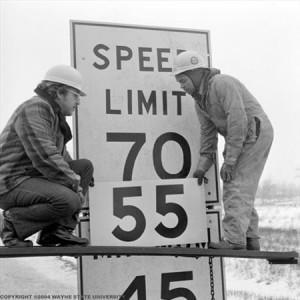
Many people (myself included) cringe at the thought of having a 55 or 60 mph speed limit on the highway. But, if we’re going to seriously address foreign oil dependence and climate change, it should at least be on the table for discussion.
When the national speed limit in the U.S. was restricted to 55 mph in 1974 (and repealed in 1995), total fuel consumption dropped by .2 to 3 percent. A more recent report by the Department of Energy, which reached similar figures, estimates that in 2008 it would have mitigated between 175,000 and 275,000 barrels of oil each day. Using these numbers, a 55 mph speed limit at 2010 gas prices would have yielded savings between $5.6 and $8.8 billion. The amount is even greater for countries with expensive fuel. A recently enacted temporary speed limit reduction in Spain (from 75 mph to 68 mph), expected to last three months, would save $3.2 billion annually.
While many factors affect fuel economy – such as vehicle-specific attributes, driving conditions, and traffic – it is generally true that a vehicle will operate most efficiently between 30 and 60 mph (source). Above this point, fuel economy decreases rapidly. To get a feel for how much time and money you’d spend at different highway speeds, take a look at MpgForSpeed’s online calculator. Compared to a baseline of 55 mph, efficiency is reduced by 8 percent at 65 mph; 17 percent at 70 mph; 23 percent at 75 mph; and 28 percent at 80 mph. The additional time spent in a car traveling at 60 mph as opposed to 75 mph would be just 6 minutes after 30 miles.
Despite having a 55 mph national speed limit for 21 years, a large poll by GasBuddy – with over 70 percent opposed – suggests it would be difficult to implement today. For the time being, driving at eco-friendly speeds will be up to you.
Image

